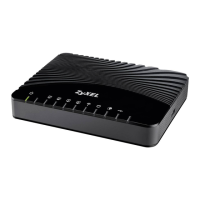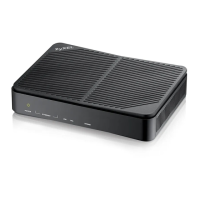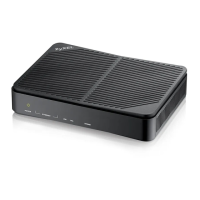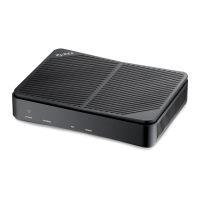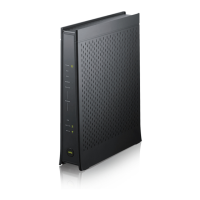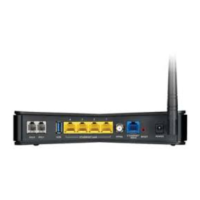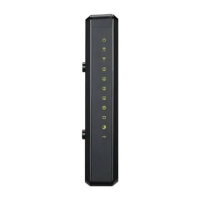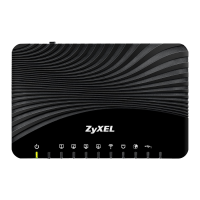
Do you have a question about the ZyXEL Communications VWG1312-B10A and is the answer not in the manual?
| Wireless Standards | 802.11b/g/n |
|---|---|
| Wireless Frequency Band | 2.4GHz |
| Wireless Data Rates | Up to 300Mbps |
| Security Features | WEP, WPA, WPA2, WPS |
| Firewall | NAT, SPI |
| QoS | Yes |
| VLAN Support | Yes |
| USB Ports | 1 x USB 2.0 |
| Antennas | 2 x external antennas |
| Operating Temperature | 0°C to 40°C |
| Storage Temperature | -20°C to 70°C |
| Humidity | 10% to 90% (non-condensing) |
| LAN Interface | 4 x 10/100 Mbps Ethernet |
| Power Supply | 12V DC |
| WAN Interface | 1 x 10/100Mbps Ethernet WAN port |
Explains common uses and scenarios for the device, such as Internet access.
Explains the procedure for restoring the device to factory default settings.
Details how to connect to the device's wireless network via Access Point.
Guides users through the initial setup wizard for time zone, Internet, and wireless settings.
Provides a step-by-step guide to setting up an ADSL PPPoE Internet connection.
Guides users on configuring secure wireless network settings using WPS or manual methods.
Explains how to create different wireless network groups with unique SSIDs and security.
Guides on prioritizing traffic using QoS queues and class setup.
Explains how to use Dynamic DNS to access the device via a domain name.
Describes how to permit or deny wireless access based on MAC addresses.
Explains how to use the device as a media server for playing files on network clients.
Guides on configuring the device as a print server for USB printers.
Allows configuration of the device's Internet access settings.
Guides users on configuring 3G connection settings for WAN backup.
Allows enabling Wireless LAN, setting SSID, and selecting security mode.
Enables and configures multiple Basic Service Sets (BSSs) on the device.
Configures exclusive access for specific devices based on MAC addresses.
Configures WiFi Protected Setup (WPS) for quick wireless network setup.
Sets up Wireless Distribution System (WDS) links between the device and other APs.
Configures the device's Local Area Network IP address and subnet mask.
Assigns specific IP addresses to individual computers based on their MAC addresses.
Configures Universal Plug and Play (UPnP) settings for automatic device discovery.
Allows viewing and configuring static route rules on the device.
Configures routing policies to override default behavior based on defined criteria.
Enables or disables QoS and sets upstream bandwidth.
Allows configuration of QoS queue assignment and management algorithms.
Enables adding, editing, or deleting QoS classifiers to sort traffic flows.
Configures QoS policers to limit the transmission rate of incoming traffic.
Forwards incoming service requests to servers on the local network.
Adds and configures the device's trigger port settings for dynamic service access.
Enables DDNS and configures the necessary settings for dynamic DNS services.
Enables file sharing server for USB devices connected to the device.
Enables or disables the sharing of media files from USB storage.
Enables the print server for sharing a USB printer on the LAN.
Sets the security level of the firewall based on packet direction.
Configures customized services, port numbers, and firewall rules.
Displays and configures incoming or outgoing filtering rules.
Activates protection against Denial of Service (DoS) attacks.
Allows wireless and LAN clients access to the device based on MAC address.
Enables parental control, views rules, and schedules.
Configures restricted access schedules and URL filtering settings.
Configures restricted access schedules for specific users on the network.
Allows generating certification requests and importing CA-signed certificates.
Allows viewing system logs by filtering severity level and category.
Displays and allows configuration of static route rules on the device.
Displays detailed DSL statistics for line, mode, traffic, and port details.
Allows changing the system password for the user account.
Configures which interfaces and services users can employ for device management.
Configures the device to be managed by an Auto Configuration Server (ACS).
Allows LAN-side DSL CPE configuration using a TR-064 compliant application.
Configures the device's time and date based on the local time zone.
Configures required information for sending email via a mail server.
Allows uploading new firmware files to the device.
Allows pinging an IP address or tracing packet routes.
Troubleshoots power issues and LED behavior.
Addresses issues related to forgetting IP addresses or passwords, and login screen access.
Helps diagnose and resolve problems with accessing the Internet via DSL or second DSL.
Identifies factors causing intermittent wireless connections and provides optimization tips.
Details TCP/IP configuration for Windows, including IP address, subnet mask, and DNS.
